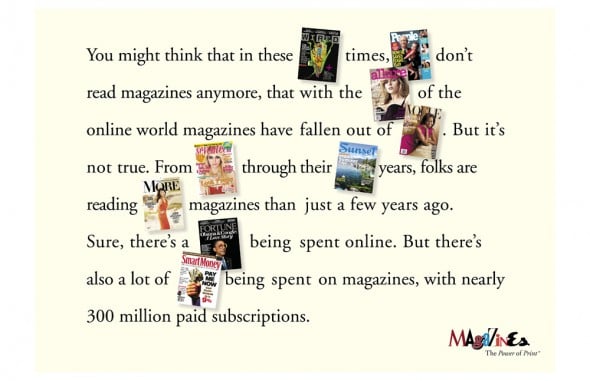
Over at Teleread, they’ve called Wired magazine onto the carpet for a set of eBook reader reviews that pitted the low-end Kindle against touchscreen, higher-end competitors, and for not breaking out the Special Offers/non-special offers versions of the Kindle. The Wired writer responsible for the segment responded in the comments, and after a few days of mulling it over, it seems to me that his explanation hurts print magazines more than it does to exonerate Wired.
For reference, the review is over two pages: Page 1, Page 2.
Here’s what Tim Conway said over at Teleread:
The problem that we had doing the roundup was that Amazon couldn’t get us a Kindle Touch unit before our editorial deadline. Review units for the Touch weren’t available until mid-November; we barely got the Kindle 4 in under the wire.
We do text, pics, design, multiple rounds of editorial, fact-checking, printing… As a web guy, it’s AMAZING how time-and-labor-intensive the print process is. It makes for a beautiful, thorough, exact product.
Ultimately, we thought it was better to get the “big four” e-reading companies’ entry-level devices all together and get the review out before Christmas.
I’m a happy owner of the Kindle 3/Kindle Keyboard. I was seriously disappointed in the Kindle 4. Amazon reduced the flash rate between page turns. The problem is that the flashes serve a function: they reset the screen. Without flashes, you get screen artifacts and muddled text. This makes the Kindle 4?s screen noticeably dimmer and blurrier than the Kobo, the Nook, or the Kindle 3. (The Pearl screen here doesn’t make a difference. And other readers have agreed with me.)
Finally, text entry, which was never easy on the Kindle 3 and still isn’t fantastic on any e-reader’s touchscreen keyboard (I think Kobo’s is the best) is a positive disasteron the Kindle 4. You can’t get rid of the physical keyboard and not have a touchscreen. I would have preferred a nine-button keyboard, like texting on a feature phone, to the abcd keyboard and the little five-way noodle. Or a click wheel. Anything.
And it turns out, you use text entry to do a lot on e-readers. Notes. Sharing. Search. Purchases! This is a substantial part of the experience of using an e-reader. And it’s seriously handicapped in the Kindle 4.
And you know what? A month later, I still would probably give the Kobo the slightest of edges over both the Nook and Kindle Touch devices. With the new Nook firmware, they’re all 8s. Each has strengths and drawbacks, but as a pure device, I really just liked the Kobo the best. (I was as surprised as anyone.)
Ok, see, it’s not biased…it’s that Wired was on a deadline! They were cramped for space and there was only so much they could do…except this excuse just highlights how limiting paper publishing has become in an era of digital reviews and reading. Effectively, they were hamstrung by a tight turnaround because they had to print the issue. And they couldn’t change the layout and explain themselves in the review without messing up the entire segment.
Here’s my take: if Wired review were digital, they could have added the Kindle Touch review later. Or they could have inserted a comment on how Amazon didn’t get them the review unit in time for the reviews, and therefore they were doing an imperfect comparison. Unfortunately, they simply didn’t have that flexibility and so they ran the review as they could, leading to Teleread’s criticism. I rarely read magazines, and honestly, it’s because of issues like this. Wired is stuck between a rock and a hard place; if they wait until everyone gets the review units to them, their reviews don’t go live until another month AFTER every newspaper, weekly magazine and blog have reviewed the devices. On the other hand, when they run with what they have, they’re forced to deliver a sub-par review. Frankly, it’s a fail either way for them.
And for what it’s worth, I agree with Teleread to an extent. If Wired didn’t have time to properly compare the four units, they shouldn’t have tossed the lower-end model into the mix and not explained there was a higher end model available. They don’t have to like the Kindle 4, and it sounds like the K4 has similar issues to the Kobo WiFi reader (I wasn’t a fan of d-pad keyboarding on that unit either). However, the article as it exists presents it as though a shopper looking for a comparable Kindle would have to settle for a Kindle 4 sans touchscreen, that Amazon was somehow behind the times. If Wired had stacked the year-old NOOKcolor against the Kindle Fire without addressing the NOOK Tablet, it would be equally dishonest by omission. It’s sloppy journalism, and if the printed word is what caused it, well, that’s a point against paper magazines.
What’s your take on Wired’s review? Are Teleread and I just being too picky? Have you stopped reading magazines because they feel so behind? Let us know in the comments!

The Wired reviewer clearly didn’t take the time to do a thorough test, or he’d have seen that the screen refresh on the newest Kindles is an option. If he prefers the screen with a refresh on every page turn, although he needs to do is go to Reading Options in the settings and turn it on. They just have it off as the default.
Wow. I didn’t know that (haven’t reviewed the newest Kindles). That really highlights what a rush job it was!